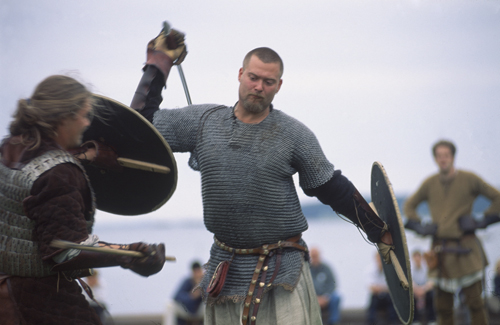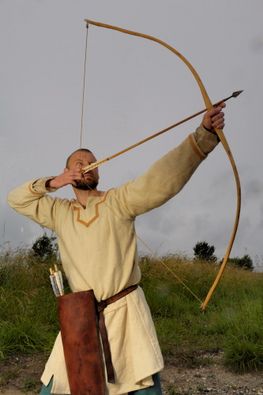
Warrior and warfare
The Sea Stallion of Glendalough is a warship and the Vikings are famous today for their warlike attacks across large parts of Europe. The written sources we have from Viking times were almost all written by the Vikings' victims or their descendants and have therefore a not particularly positive attitude to the Vikings. The great majority of Vikings were completely peaceful people, but finds of weapons and written accounts concerning attacks and power struggles, for example in the British Isles, speak volumes concerning the warrior culture of the time.
- How was a warship equipped and who was responsible for obtaining weapons for the ship?
- Why were there so many arrows on the warships? Were they intended to be used once the ship reached land or were many arrows shot from ship to ship?
- Bayeux Tapestry shows that the Normans took their horses with them. Did the Vikings and the English also use horses in battle.
- What kind of equipment would a warrior from Scandinavia have with him?
- What kind of equipment would a English/Saxon warrior have with him?
- What kind of equipment would a Norman warrior have with him?
- What would the Battle of Hastings be like today relative to the battle in Viking times?
- Evaluate the troops of the two leaders – how many weapons, archers etc. did they have?
- What were the political consequences of the Battle of Hastings?
- Are there differences between the warriors' rank and their duties during a battle?
- Compare the various parties involved in the Battle for England and consider the factors which resulted in the battles ending as they did.
- Draw and label a Viking warrior.
- Write and illustrate a list of the weapons the Vikings had with them.
- Draw yourself at life size on a piece of paper and change yourself into a Viking warrior.
- Make your own arrow.
- Write a skaldic epic about a Viking battle.
- Draw a cartoon series about an attack on a monastery (perhaps could find inspiration in the text on Iona).
- Imagine that you are a Viking or one of his opponents. Write in your diary about your experiences in battle (perhaps you could find inspiration in the texts about Hastings, Stamford Bridge or Clontarf).
Warrior and battle
This exercise contains problems, suggestions for written work and practical activities, in addition to the worksheet The Vikings' bow and arrow which includes instructions for making your own hunting arrow and acting out the role-play The Battle for England.
This exercise deals with topics such as:
- The warship's equipment
- The Viking warrior and his equipment
- Normans versus Saxons/English
- The Viking Age versus modern times
- The Battle for England
- The Vikings in England
The following places and subjects described on the Sea Stallion website may help in solving the exercise: Holumen and crew, Clontarf, Iona, The Vikings in England, Written sources for the Viking Age, Iconographic sources for the Viking Age, Hastings, Stamford Bridge, The battle for England, Aggersborg and the role-play The Battle for England. Also use the library and the Internet for further inspiration and information. For example www.youtube.com contains a series of video clips from 2006 showing Viking re-enactment groups recreating elements from The Battle of Hastings 1066.
This exercise can be used for both the ages 10-15 and 16-20, by setting appropriate sets of questions and activities.
The exercise, or parts of it, may overlap with several different study projects, for example The Vikings' Warship, The Vikings in England, The Battle for England, Sources for the Viking Age, and can therefore be used in combination with several other exercises from the Sea Stallion's home page; for example Ship building, The Vikings in England, The Battle for England, Who writes history? and Historical criticism
Subjects: Woodwork, Art, History, English, General studies
Suitable for age: 10-15 & 16-20 years.
Tools
- norman shield EN.pdf
- make your own shield
- sword EN.pdf
- make your own sword
- Microsoft Word - OK Pil udskriftsark 2 EN.doc
- make your own arrow
